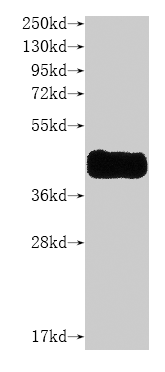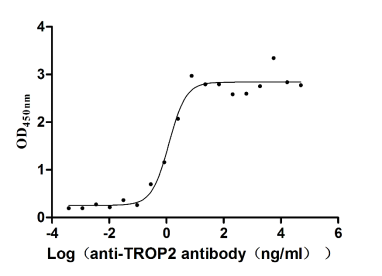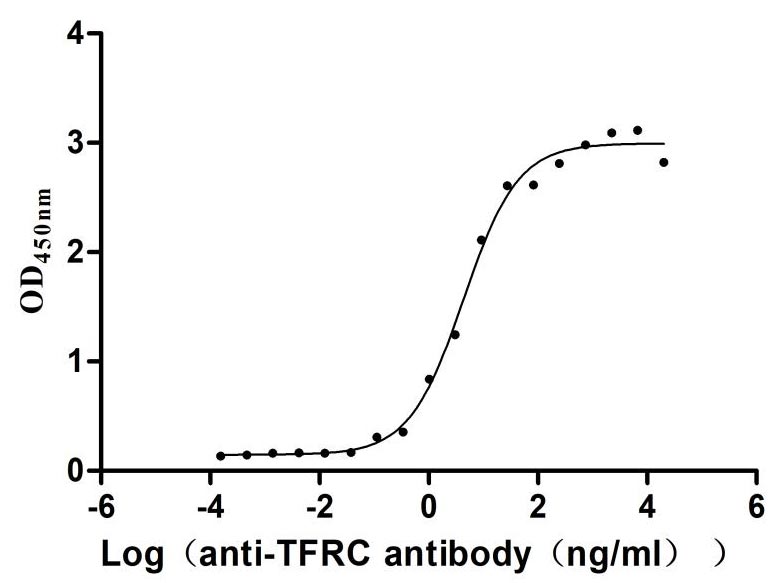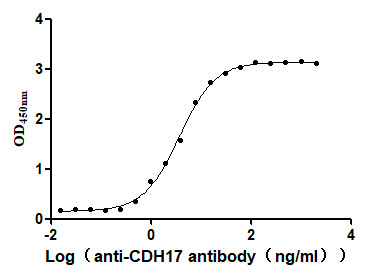Recombinant Human B-cell CLL/lymphoma 9 protein (BCL9), partial
-
中文名稱:Recombinant Human B-cell CLL/lymphoma 9 protein(BCL9) ,partial
-
貨號:CSB-YP002631HU
-
說明書:
-
規格:
-
來源:Yeast
-
其他:
-
中文名稱:Recombinant Human B-cell CLL/lymphoma 9 protein(BCL9) ,partial
-
貨號:CSB-EP002631HU-B
-
說明書:
-
規格:
-
來源:E.coli
-
共軛:Avi-tag Biotinylated
E. coli biotin ligase (BirA) is highly specific in covalently attaching biotin to the 15 amino acid AviTag peptide. This recombinant protein was biotinylated in vivo by AviTag-BirA technology, which method is BriA catalyzes amide linkage between the biotin and the specific lysine of the AviTag.
-
其他:
-
中文名稱:Recombinant Human B-cell CLL/lymphoma 9 protein(BCL9) ,partial
-
貨號:CSB-BP002631HU
-
說明書:
-
規格:
-
來源:Baculovirus
-
其他:
產品詳情
-
純度:>85% (SDS-PAGE)
-
基因名:
-
Uniprot No.:
-
別名:BCL9B-cell CLL/lymphoma 9 protein; B-cell lymphoma 9 protein; Bcl-9; Protein legless homolog
-
種屬:Homo sapiens (Human)
-
蛋白長度:Partial
-
蛋白標簽:Tag?type?will?be?determined?during?the?manufacturing?process.
The tag type will be determined during production process. If you have specified tag type, please tell us and we will develop the specified tag preferentially. -
產品提供形式:Lyophilized powder Warning: in_array() expects parameter 2 to be array, null given in /www/web/cusabio_cn/public_html/caches/caches_template/default/content/show_product_protein.php on line 662
Note: We will preferentially ship the format that we have in stock, however, if you have any special requirement for the format, please remark your requirement when placing the order, we will prepare according to your demand. -
復溶:We recommend that this vial be briefly centrifuged prior to opening to bring the contents to the bottom. Please reconstitute protein in deionized sterile water to a concentration of 0.1-1.0 mg/mL.We recommend to add 5-50% of glycerol (final concentration) and aliquot for long-term storage at -20℃/-80℃. Our default final concentration of glycerol is 50%. Customers could use it as reference.
-
儲存條件:Store at -20°C/-80°C upon receipt, aliquoting is necessary for mutiple use. Avoid repeated freeze-thaw cycles.
-
保質期:The shelf life is related to many factors, storage state, buffer ingredients, storage temperature and the stability of the protein itself.
Generally, the shelf life of liquid form is 6 months at -20°C/-80°C. The shelf life of lyophilized form is 12 months at -20°C/-80°C. -
貨期:Delivery time may differ from different purchasing way or location, please kindly consult your local distributors for specific delivery time.Note: All of our proteins are default shipped with normal blue ice packs, if you request to ship with dry ice, please communicate with us in advance and extra fees will be charged.
-
注意事項:Repeated freezing and thawing is not recommended. Store working aliquots at 4°C for up to one week.
-
Datasheet :Please contact us to get it.
相關產品
靶點詳情
-
功能:Involved in signal transduction through the Wnt pathway. Promotes beta-catenin's transcriptional activity.
-
基因功能參考文獻:
- Specific regulation of BCL9 expression by HIF-1alpha may prove to be an underlying crosstalk between Wnt/beta-catenin signaling and hypoxia signaling pathways. PMID: 28074862
- Results find that BCL9 is upregulated in osteosarcoma (OS) tissues and promotes OS proliferation, migration and invasion. BCL9 is a downstream target of miR-1301 in OS cells. In addition, BCL9 restoration could reversed the functional effects of miR-1301 overexpression on OS cell proliferation, migration and invasion. These results revealed the important role of BCL9 in OS tumor progression. PMID: 30172867
- High BCL9 expression is associated with cisplatin-resistance in non-small cell lung cancer. PMID: 30009824
- miR-1301 inhibits hepatocellular carcinoma cell migration, invasion, and angiogenesis by decreasing Wnt/beta-catenin signaling through targeting BCL9. PMID: 28817119
- results from this study demonstrated that hypoxia induced BCL-9 expression in human CRC cells mainly through HIF-1alpha, which could be an important underlying mechanism for increased BCL-9 expression in CRC. PMID: 27121066
- SOX7 inhibits oncogenic beta-catenin-mediated transcription by disrupting the beta-catenin/BCL9 interaction. PMID: 29271667
- The authors used CRISPR/Cas9 genome engineering of Drosophila legless (lgs) and human BCL9 and B9L to show that the C-terminus downstream of their adaptor elements is crucial for Wnt responses. PMID: 28296634
- MEF2D-BCL9-positive patients had B-cell precursor immunophenotype and were characterized as being older in age, being resistant to chemotherapy, having very early relapse, and having leukemic blasts that mimic morphologically mature B-cell leukemia with markedly high expression of HDAC9. PMID: 27507882
- it was demonstrated that miR218 modulated a novel molecular target and the present study provided novel insights into potential mechanisms of RCC oncogenesis. PMID: 27314976
- findings indicate that BCL9 most likely does not harbor a common genetic variant that can increase the risk for schizophrenia in the Japanese population PMID: 26494551
- BCL9/9L-beta-catenin Signaling is Associated With Poor Outcome in Colorectal Cancer PMID: 26844272
- BCL9 is a molecular driver of DCIS invasive progression. PMID: 26384318
- PCDH10 antagonized MM cell proliferation via the downregulation of Wnt/beta-catenin/BCL-9 signaling, whereas PCDH10 repressed the expression of AKT to promote the expression of GSK3beta and then to restrain the activation of beta-catenin PMID: 26081897
- By beta-catenin's association with LEF1 and BCL9-2/B9L. PMID: 24419084
- MiR-30-5p downregulation occurs as a result of interaction between multiple myeloma cells and bone marrow stromal cells, which in turn enhances expression of BCL9. PMID: 24599134
- we detected five SNPs in the first two genes/loci - BCL9 and C9orf5 - strongly associated with negative symptoms of schizophrenia PMID: 23382809
- Inhibition of the BCL9-beta-catenin interaction and selectively suppresses oncogenic Wnt transcription. PMID: 22914623
- growth factor induced proliferation mediates a neutralizing response by significantly increasing miR-30c-2* which reduces BCL9 expression and cell proliferation in SKOV-3 and OVCAR-3 cells PMID: 22024689
- These findings indicate that common variations in the BCL9 gene confer risk of schizophrenia and may also be associated with bipolar disorder and major depressive disorder in the Chinese Han population. PMID: 21383261
- Pygo2 PHD is the only known PHD finger that is capable of interacting simultaneously with two functional ligands, B9L and BCL9 PMID: 20637214
- crystallographic analysis of how beta-catenin, BCL9, BCL9-2 and Tcf4 interact PMID: 17052462
- BCL9 itself contains a transcriptional activation domain in the C terminus, which functionally synergizes in lymphoid cells with the C-terminal transactivation domain of beta-catenin. PMID: 18347063
- Data show that human and Drosophila Pygo PHD fingers associate with their cognate HD1 domains from BCL9/Legless to bind specifically to the histone H3 tail methylated at lysine 4 (H3K4me). PMID: 18498752
- Overexpression and altered subcellular localization of ATG16L1 protein in human oral squamous-cell carcinoma: correlation with lymphovascular invasion and lymph-node metastasis are reported. PMID: 18789482
- The amino-terminus of the BCL9 peptide is critical for maintaining the wild-type binding affinity of the BCL9 peptide to beta-catenin. PMID: 19715304
- Findings suggest that deregulation of BCL9 is an important contributing factor to tumor progression in multiple myeloma and colon neoplasms. PMID: 19738061
顯示更多
收起更多
-
相關疾病:A chromosomal aberration involving BCL9 is found in a patient with precursor B-cell acute lymphoblastic leukemia (ALL). Translocation t(1;14)(q21;q32). This translocation leaves the coding region intact, but may have pathogenic effects due to alterations in the expression level of BCL9. Several cases of translocations within the 3'-UTR of BCL9 have been found in B-cell malignancies.
-
亞細胞定位:Nucleus.
-
蛋白家族:BCL9 family
-
組織特異性:Detected at low levels in thymus, prostate, testis, ovary and small intestine, and at lower levels in spleen, colon and blood.
-
數據庫鏈接:
Most popular with customers
-
Recombinant Human Angiotensin-converting enzyme 2 (ACE2), partial (Active)
Express system: Mammalian cell
Species: Homo sapiens (Human)
-
Recombinant Severe acute respiratory syndrome coronavirus Spike glycoprotein (S), partial (Active)
Express system: Mammalian cell
Species: Human SARS coronavirus (SARS-CoV) (Severe acute respiratory syndrome coronavirus)
-
Recombinant Human Poliovirus receptor (PVR) (I340M), partial (Active)
Express system: Mammalian cell
Species: Homo sapiens (Human)
-
Recombinant Mouse Prolactin receptor (Prlr), partial (Active)
Express system: Mammalian cell
Species: Mus musculus (Mouse)
-
Recombinant Human C-C chemokine receptor type 8 (CCR8)-VLPs (Active)
Express system: Mammalian cell
Species: Homo sapiens (Human)
-
Recombinant Human Tumor-associated calcium signal transducer 2 (TACSTD2), partial (Active)
Express system: Mammalian cell
Species: Homo sapiens (Human)
-
Recombinant Human Transferrin receptor protein 1 (TFRC), partial (Active)
Express system: Mammalian cell
Species: Homo sapiens (Human)
-
Recombinant Human Cadherin-17 (CDH17), partial (Active)
Express system: Mammalian cell
Species: Homo sapiens (Human)


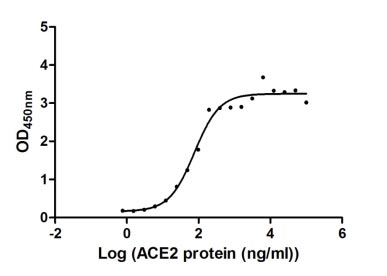

-AC1.jpg)

